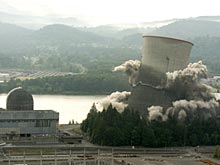 |
| Sequential charge starts the implosion. (Photo courtesy of PGE)
|
With a sequenced flash of explosives followed by a muffled thump, the Portland General Electric Trojan nuclear powerplant’s 499-ft-tall cooling tower collapsed upon itself in a cloud of dust early May 20. Hundreds of safely distant onlookers and photographers turned out on a sunny spring Sunday morning to watch a visible monument to Oregon’s nuclear power era consigned to the scrap heap.
The state’s only nuclear plant was commissioned in 1976, shut down after inspectors discovered cracks in the steam generators and finally decommissioned the unit in 1993. In the interim an active Northwestern anti-nuclear movement had placed the plant at the top of its hit list. The state legislature had passed a bill banning construction of new nuclear units until the federal government clears Yucca Mountain or some other nuclear waste repository to take radioactive spent fuel. Even if that should come to pass, Oregon voters would have to vote in favor of any new nuke. Reading the writing on the wall, PGE opted to purchase cheaper power on the open market and develop new sources from hydro, wind and natural gas.
|
The utility will spend about $408 million on the total decommissioning, says Patty Farrell, a PGE spokesperson. The implosion cost about $3.9 million. The reactor is buried at the Hanford site in Washington state, she adds. Spent fuel rods are onsite, encased in concrete, awaiting eventual shipment to a permanent federal facility.
Six weeks of elaborate preparation preceded the implosion, which took only about nine seconds, says Mark Loizeaux, president of Phoenix, Md.-based CDI. The contractor drilled 2,934 holes the 41,000-ton structure. The key points were in 44 support columns, in two horizontal bands at the 100-ft and 250-ft levels and in vertical stripes. Some 2,792 lbs of explosives were sequenced over 2.5 seconds to induce the structure to fall away from the spent fuel storage facility, Loizeaux says. The contractor, which has blended the sciences of blasting and civil engineering into a profitable and entertaining art form, prides itself on maximum safety and minimal disruption during events. Authorities reported that Interstate 5 nearby was closed for about 12 minutes and the road closest to the plant, Oregon Route 30, for a few minutes more. There were no injuries reported to humans or wildlife in the area.
CDI, which sets the standard for expertise in spectacular but safe controlled structural implosions, says the blast was the largest cooling tower implosion ever, worldwide. CDI will drop four towers at the Sellafield nuclear complex in the UK this summer. British Nuclear Group sent representatives to see the Trojan implosion, Loizeaux says.


Post a comment to this article
Report Abusive Comment